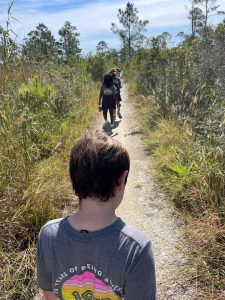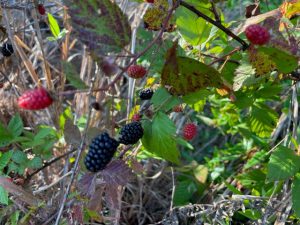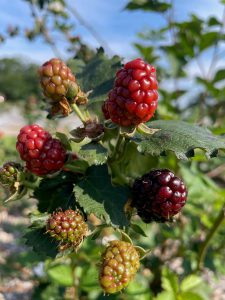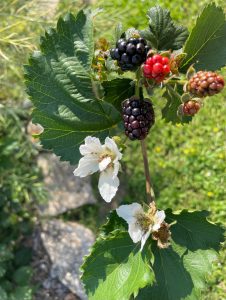
Last fall, I led a group of 4th graders down a section of the Florida Trail at Ft. Pickens. As we walked, I would point out interesting plants or animals, noting some of the plants were edible. Several of the kids were so captivated with the idea of free snacks along the trail that soon, a chorus of, “Can we eat this?” followed at nearly every stop along the path.
I understand this fascination—in fact, it’s probably one of the earliest human needs—our ancestors subsisted primarily on hunting and gathering. The “gathering” aspect would have been a lot safer and a more regular addition to the diet, whereas tracking down meat took a lot of energy and a considerable amount of risk.

As we feel summer warming up around us, one of the south’s most reliable edible plants is bursting with fruit. The wild blackberry (Rubus spp.), also known as the dewberry, is tough and thorny and will grow in shade, sun, disturbed soil, roadside ditches, and cracks in the sidewalk.

The plants are loaded with complex “aggregate” berries, starting out as a spring green color and morphing over time to a bright maroon and a deep purple/black. It’s in this dark phase with you’ll want to pick the berries—anything earlier can be pretty tart. They also will not ripen further once you pick them, so what you pick is what you taste. Blackberries are super healthy—full of fiber and vitamin C—and are great just by themselves or incorporated into breakfast dishes, salads, and desserts.

You can, of course, buy varieties of blackberries to grow at home. These cultivated plants typically yield larger berries and have fewer, or no, thorns. They have a more upright growth habit, while the wild roadside ones spread low to the ground.
Wild blackberries can be a human nuisance, for sure, due to the painful thorns. The prickly stems can be dangerous for cattle, which can end up with infections or reproductive and lactation complications from severe scratches on their underbellies.
We typically reach a compromise with the blackberries that pop up in our yard. I like to keep them around long enough to produce fruit this time of year, but once they’re past that point, they’ll be cut down and mowed so no one ends up with an ankle full of tiny thorns.
If you’re along a trail over the next month, be sure to look around for wild blackberries, and point them out to your kids—free snacks abound!
 12
12
